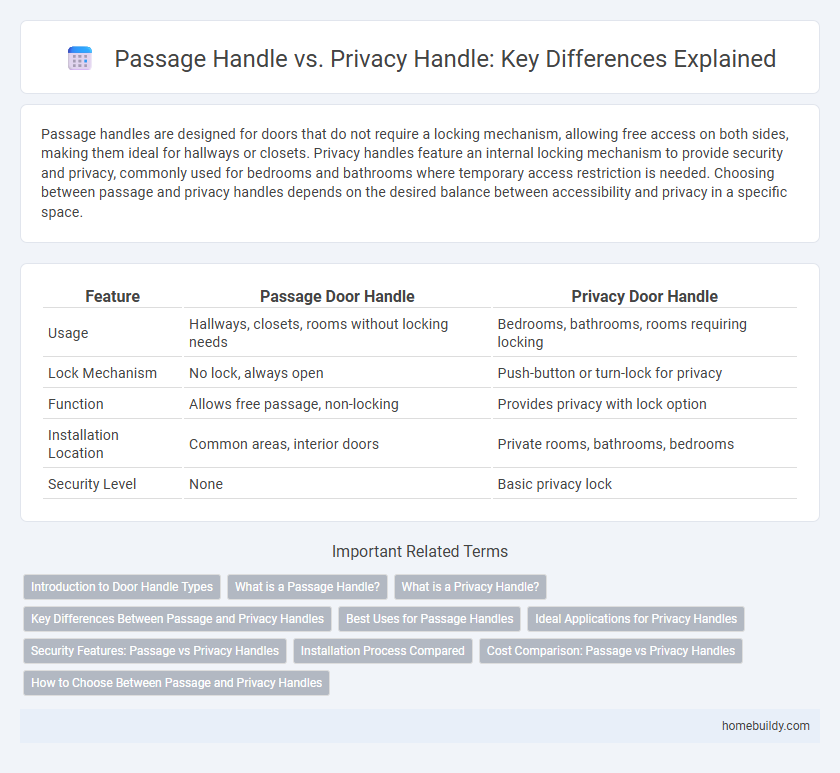Passage handles are designed for doors that do not require a locking mechanism, allowing free access on both sides, making them ideal for hallways or closets. Privacy handles feature an internal locking mechanism to provide security and privacy, commonly used for bedrooms and bathrooms where temporary access restriction is needed. Choosing between passage and privacy handles depends on the desired balance between accessibility and privacy in a specific space.
Table of Comparison
| Feature | Passage Door Handle | Privacy Door Handle |
|---|---|---|
| Usage | Hallways, closets, rooms without locking needs | Bedrooms, bathrooms, rooms requiring locking |
| Lock Mechanism | No lock, always open | Push-button or turn-lock for privacy |
| Function | Allows free passage, non-locking | Provides privacy with lock option |
| Installation Location | Common areas, interior doors | Private rooms, bathrooms, bedrooms |
| Security Level | None | Basic privacy lock |
Introduction to Door Handle Types
Passage handles are designed for doors that do not require locking, providing easy access and smooth operation in areas like hallways or closets. Privacy handles include a locking mechanism, making them ideal for bedrooms or bathrooms where temporary privacy is needed. Both types offer distinct functional benefits tailored to different door security and accessibility needs.
What is a Passage Handle?
A passage handle is a type of door hardware designed for rooms where locking is not required, such as hallways or closets. It allows free movement between spaces with a simple latch mechanism that can be opened from either side without a key or locking feature. Unlike privacy handles, passage handles do not have a locking function, prioritizing accessibility and convenience in frequently used areas.
What is a Privacy Handle?
A privacy handle is a door handle designed with a locking mechanism that allows occupants to secure a room from the inside, typically used in bedrooms and bathrooms for personal privacy. Unlike a passage handle, which provides no locking feature and is meant for doors that do not require privacy, a privacy handle includes either a push-button or thumb-turn lock. This locking function helps ensure that the room remains private, preventing access without a key or an emergency release on the exterior side.
Key Differences Between Passage and Privacy Handles
Passage handles are designed for doors that do not require locking, commonly used in hallways or closets, allowing free access from both sides without any locking mechanism. Privacy handles feature a locking mechanism with a push-button or turn lock, ideal for bedrooms and bathrooms where temporary privacy is needed. The primary difference lies in the locking capability and intended use--passage handles offer accessibility while privacy handles provide security and seclusion.
Best Uses for Passage Handles
Passage door handles are best used for rooms that do not require locking, such as hallways, closets, and common areas, offering easy access and smooth operation. Unlike privacy handles, which have a locking mechanism for bedrooms or bathrooms, passage handles provide functionality without security features, making them ideal for frequently accessed interior doors. Their simple design and ease of use enhance convenience in spaces where privacy is unnecessary.
Ideal Applications for Privacy Handles
Privacy door handles are ideal for bedrooms, bathrooms, and home offices where occupants require a secure locking mechanism without the need for a key. These handles feature an internal locking button or thumb turn that allows easy locking from the inside and emergency unlocking from the outside. Their design ensures personal privacy while maintaining quick access in case of emergencies, making them perfect for residential and commercial applications demanding both security and convenience.
Security Features: Passage vs Privacy Handles
Privacy door handles incorporate built-in locking mechanisms providing enhanced security by allowing the door to be locked from the inside, suitable for bedrooms or bathrooms. Passage handles lack locking features, serving mainly for doors where security is not a concern, such as hallway or closet doors. The choice between passage and privacy handles depends on the need for security and privacy control within specific rooms.
Installation Process Compared
Passage door handles feature a straightforward installation process requiring only basic tools and no lock mechanism, making them ideal for interior doors that do not require privacy. Privacy handles involve a more complex installation, as they include a locking mechanism that necessitates precise alignment of the latch and lockset components. The added step of securing the privacy lock typically extends the installation time compared to the simpler passage handle setup.
Cost Comparison: Passage vs Privacy Handles
Passage door handles are generally more affordable than privacy handles due to their simpler design and lack of locking mechanisms. Privacy handles incorporate internal locking features, increasing manufacturing complexity and material costs, which results in a higher price point. Choosing between passage and privacy handles depends on budget constraints and the need for security in a given space.
How to Choose Between Passage and Privacy Handles
Choosing between passage and privacy door handles depends on the functional needs of the space; passage handles provide easy, non-locking access ideal for areas like hallways or closets, while privacy handles include locking mechanisms suited for bedrooms and bathrooms. Consider the level of privacy required and the door's location when selecting a handle type. Evaluate ease of use, security features, and compatibility with your door's thickness and style to make the optimal choice.
Passage handle vs Privacy handle Infographic

 homebuildy.com
homebuildy.com